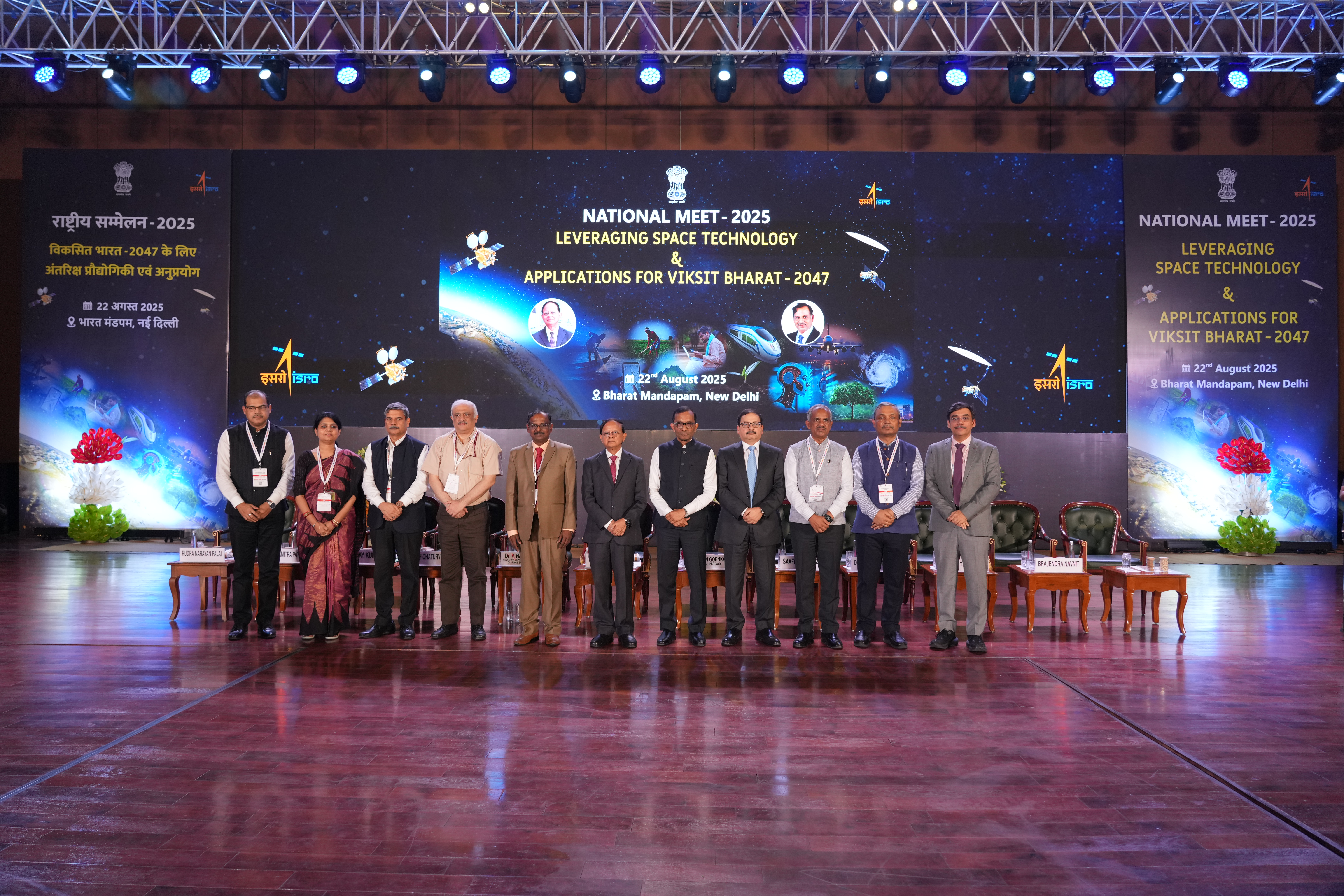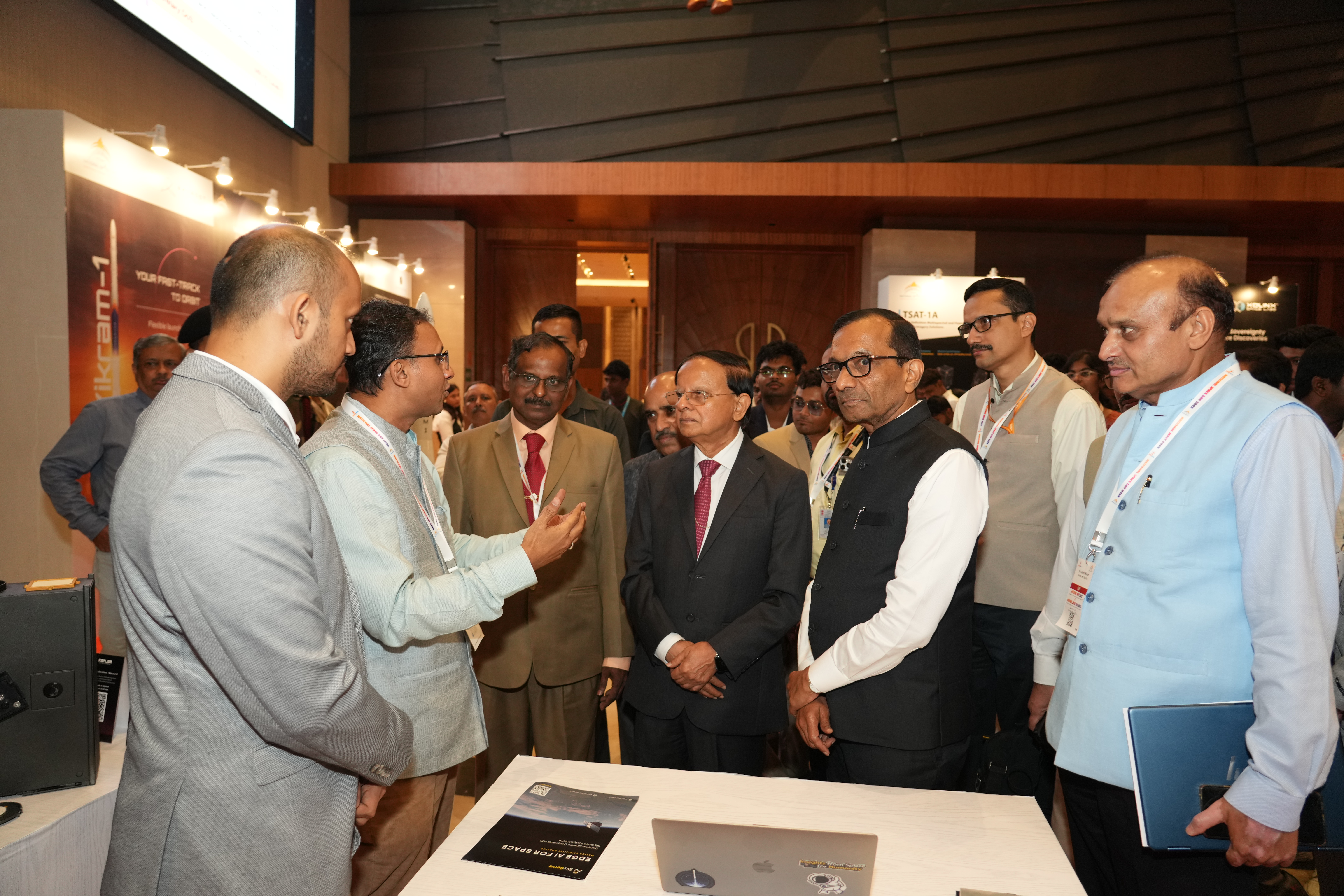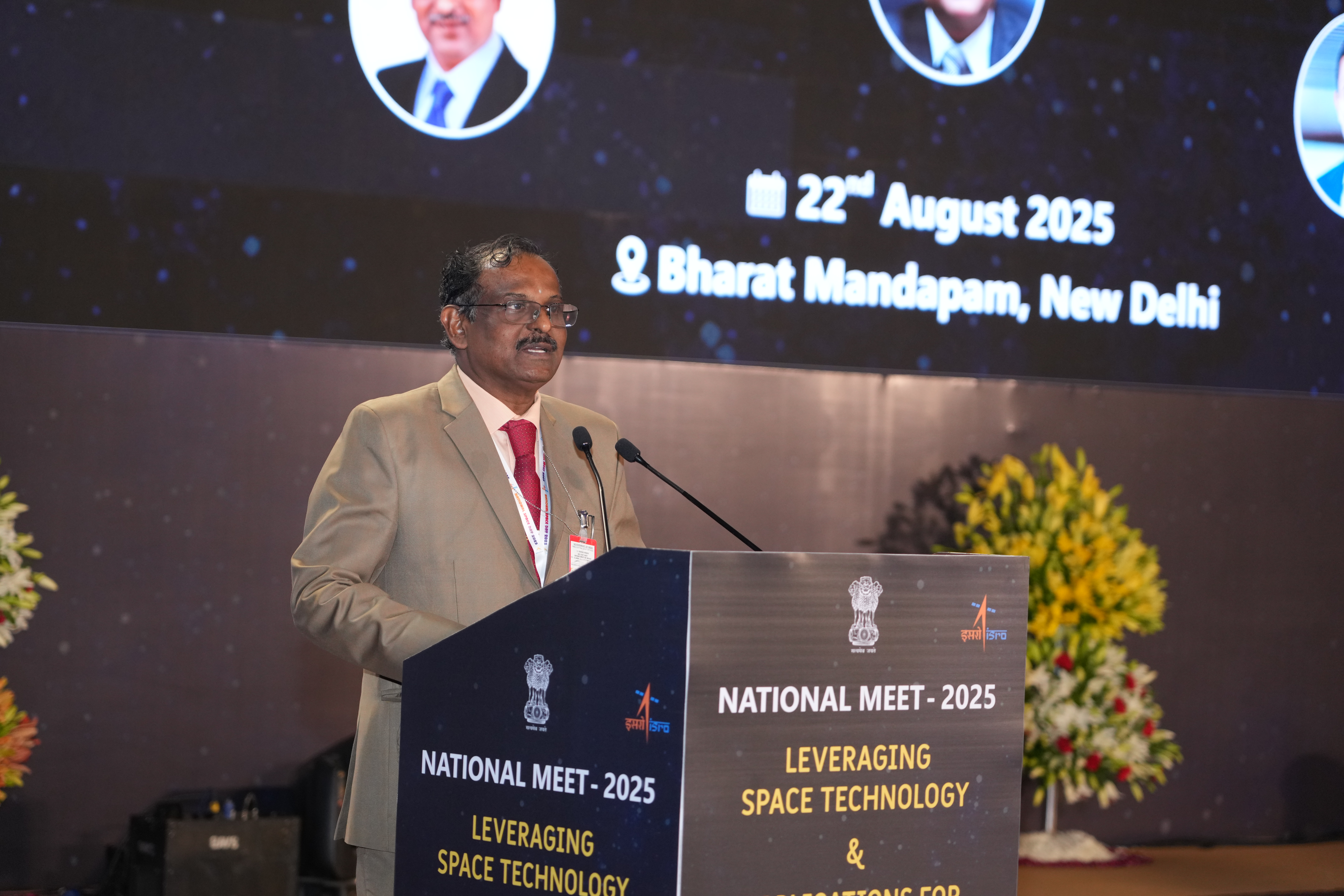ISRO’s National Space Meet 2.0 Charts Roadmap for Viksit Bharat 2047 Through Space Applications
ISRO’s National Space Meet 2.0 Charts Roadmap for Viksit Bharat 2047 Through Space Applications
As part of the 2nd National Space Day celebrations, commemorating the successful soft landing of the Vikram rover on the lunar surface, the Indian Space Research Organisation (ISRO) today hosted the National Space Meet 2.0 on “Leveraging Space Technology and Applications for Viksit Bharat 2047” at Bharat Mandapam, New Delhi.
The Meet marks a historic milestone, bringing together Union Government Ministries, State Governments, Private Sector, Academia, Startups, and Experts to shape the next decade of India’s space applications roadmap. A similar national meet was held in 2015, which guided governance and reforms through space-based solutions over the last decade. The new edition sets an ambitious agenda to redefine governance, strengthen citizen-centric service delivery, and harness space technology for socio-economic transformation, aligning with the vision of Viksit Bharat@2047.
The Meet featured 10 breakout sessions, chaired by Secretaries and senior officials of Union Ministries and Departments, covering:
These sessions engaged hundreds of experts who, over the past four months, worked closely with Ministries, Departments, State Governments, and ISRO to identify hundreds of use cases for immediate and future implementation.
Chief guest Shri P.K. Mishra, Principal Secretary to the Prime Minister of India, at the concluding ceremony, hailed India’s space journey as a shining example of collective resolve by ministries, states, industries, scientists, and startups. He emphasized that the Meet embodies the ‘whole-of-government’ approach, showcasing how over 60 departments have mainstreamed satellites, navigation, and geospatial tools into governance—from agriculture and health to disaster management and climate resilience.
Reflecting on the paradigm shift initiated in 2012 by the Hon’ble Prime Minister Shri Narendra Modi, Shri Mishra noted that reforms and policies have unlocked unprecedented opportunities. From just one or two startups in 2014, the sector has now expanded to more than 350 startups, some already launching satellites and rockets from Indian soil. He lauded ISRO for creating a vibrant ecosystem by mentoring youth and startups, while reforms such as spectrum allocation, venture capital funds, and technology transfer have made India’s space sector scalable, innovative, and resilient.
He further urged for institutionalizing the National Space Meet on a regular basis, enabling greater private sector participation, and building a roadmap to integrate emerging technologies such as AI, quantum computing, and big data analytics into satellite and ground systems. He also underlined the need to expand global collaborations, citing the NASA-ISRO SAR mission and the upcoming G20 Satellites for Climate initiative as examples. Concluding with a visionary call, he stated:
“India’s space journey is about empowering citizens, bridging divides, and building a self-reliant nation. As we march towards Viksit Bharat 2047, space will be one of the strongest enablers of growth and transformation.”
Shri Pawan Goenka, Chairman, IN-SPACe, emphasized that National Meet 2.0 is not a theoretical conference but a hands-on problem-solving exercise. He highlighted the importance of a “Whole-of-Government and Whole-of-Nation” approach, where experts worked alongside Ministries and States to co-create solutions.
Reflecting on the journey from 2015 to 2025, Shri Goenka noted that while knowledge of space technology has expanded, the defining difference today lies in the thriving private sector ecosystem. He stressed that space reforms and rising demand for space-based data will create a virtuous cycle of innovation. Addressing both government and industry, he urged Secretaries to place greater trust in private sector capabilities, while encouraging startups to see space not merely as a business opportunity but as a national mission.
He envisioned a future where space technology reaches every farmer, every student, and every community, strengthening the foundation of a resilient and prosperous Bharat.
Shri V. Narayanan, ISRO Chairman, traced India’s remarkable space journey from the humble rocket launches at Thumba in 1963 to today’s global recognition of India’s leadership in space. Recalling historic milestones such as the ATS-6 experiment of 1975, he highlighted the contrast between educating 2,400 TV sets in rural India and the present fleet of 55 operational satellites powering broadcasting, telecom, telemedicine, disaster warning, and fisheries monitoring.
Outlining the agenda for the next decade, Shri Narayanan emphasized:
He set a bold target: by 2040, India will stand at par with global leaders in rockets, satellites, and applications, making a significant contribution to Viksit Bharat 2047.
Dr. V.K. Saraswat, NITI Aayog Member and former DRDO Chief, highlighted India’s rapid progress in space technology and governance transformation. Since 2015, ministries have embedded space applications into their workflows across agriculture, biodiversity, roads, health, disaster management, and climate response, resulting in major governance transformation.
He lauded landmark reforms such as the Geospatial Policy 2022, the Indian Space Policy 2023, and the creation of IN-SPACe, noting India’s shift to a demand-driven, partnership-based model aligned with Space 4.0.
Dr. Saraswat highlighted the momentum of the private sector, with startups like Skyroot, Agnikul, Pixxel, Dhruva, and Digantara driving innovation in launch, satellites, and data services. He stressed the dual dimension of space for defense and security, calling for resilient, indigenous technologies to safeguard space assets.
Looking ahead, he proposed an International Alliance on Space to address global challenges such as surveillance, debris mitigation, space-based energy, mining, and legal frameworks, urging participants to collaborate across government, industry, academia, and startups to deliver benefits to every citizen.
The concluding session outlined the way forward, emphasizing the establishment of a Pan-India consultative mechanism for aggregating user demand, the expansion of Earth Observation (EO), SATNAV, and SATCOM services to further enhance the national space economy, and the development of a comprehensive roadmap to deploy 119 EO, SATNAV, and SATCOM satellites by 2040.
The key strategies include developing government-led infrastructure for societal and governance applications using moderate-to-coarse resolution satellites and NAVIC, promoting a Public-Private Partnership (PPP) model for commercially viable high- to very high-resolution satellites and communication satellites, and strengthening infrastructure for technology demonstration, with ISRO spearheading technology development under the Department of Space.
The Meet also featured an industry session led by Shri Pawan Goenka, Chairman, IN-SPACe, co-chaired by Shri Mohan M, Director, LPSC.
National Meet 2.0 underlined ISRO’s commitment to “reimagining governance for the 21st century”, using space technology not just for scientific prestige, but for daily service delivery to citizens, aligning with Prime Minister Narendra Modi’s vision of Atmanirbhar and Viksit Bharat.
The roadmap sets ambitious yet achievable target Such as Triple the number of operational satellites in 3 years, Expand applications across all sectors and Position India among the top global space powers by 2040
Key participants included Sh. Devesh Chaturvedi, Shri Tanmay Kumar, Shri Manoj Joshi, Shri Rudra Narayan Palai, Shri Safi Ahsan Rizvi, Dr. M. Ravichandran, Shri Chanchal Kumar, Shri Brajendra Navnit, Shri Sanjay Dubey.
The sessions were co-chaired by Shri Nilesh Desai, Shri Padmakumar E S, Shri J Asir Packiaraj, Dr. K V Sriram, Dr. A K Anil Kumar, Dr. A K Patra, Shri Sowmiyanarayanan L., Dr. S.P. Aggarwal, Dr. R P Singh, Shri Pankaj D Killedar.
*****


